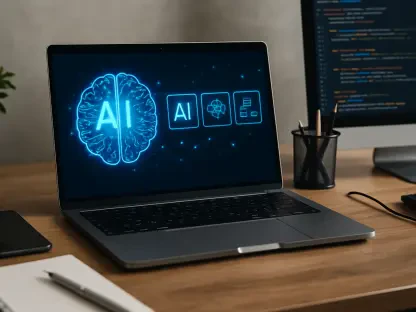The Rise of AI in Cloud-Native Ecosystems
In an era where digital transformation dictates the pace of business, cloud-native development stands as a cornerstone of modern software engineering, enabling organizations to build scalable, resilient applications tailored for dynamic cloud environments. This approach, rooted in microservices, containers, and continuous delivery, has become indispensable for companies aiming to stay competitive. However, a new force is reshaping this landscape: artificial intelligence (AI) agents are emerging as vital collaborators, moving beyond mere tools to actively drive innovation and efficiency in development workflows.
The integration of AI into cloud-native ecosystems marks a significant departure from traditional, manual processes that often bogged down DevOps and platform engineering teams. Automation powered by AI is now streamlining complex tasks, from code generation to infrastructure management, reducing human error and accelerating delivery timelines. John Pettit, CTO at Promevo, emphasizes this shift, noting that AI acts as a tireless partner, enhancing decision-making and freeing up engineers to focus on strategic priorities rather than repetitive chores.
This evolution reflects a broader industry trend toward intelligent systems that adapt and learn within distributed cloud environments. AI agents are not just automating routine tasks but also providing actionable insights, fundamentally changing how teams approach software creation and deployment. As this technology continues to mature, its role in reshaping operational paradigms becomes increasingly evident, setting the stage for a deeper exploration of its impacts.
Key Impacts of AI Agents on Cloud-Native Workflows
Enhancing Efficiency and Automation Across the SDLC
AI agents are revolutionizing the software development lifecycle (SDLC) by injecting speed and precision into every phase, from coding to deployment. These intelligent systems orchestrate pipelines in real time, monitor infrastructure for anomalies, and automate testing and debugging processes that once consumed countless hours. The result is a dramatic reduction in deployment cycles, often shrinking timelines from days to mere minutes, akin to transforming a slow manual process into a high-speed automated assembly line.
Consider AI as a set of intelligent sensors, constantly scanning for inefficiencies or errors, or as expert QA engineers capable of writing thousands of test cases and adapting to changes in user interfaces. This capability ensures that edge cases are caught early, minimizing downstream issues. Such automation not only saves time but also enhances the quality of software, allowing teams to deliver robust applications with greater confidence and consistency.
The impact on productivity is palpable, as AI-driven tools handle repetitive tasks, enabling developers to tackle more complex challenges. This shift is redefining operational efficiency, with real-time orchestration ensuring that resources are allocated optimally. As a result, organizations can respond swiftly to market demands, maintaining a competitive edge in an ever-evolving technological landscape.
Driving Cost Reduction and System Resilience
Beyond efficiency, AI agents play a crucial role in slashing costs within cloud-native development by preventing flawed code from reaching production. By identifying and blocking bad merges before they cause widespread issues, these systems save thousands of engineering hours and significant financial resources. This proactive approach acts as a buffer against costly downtime and rework, ensuring smoother project execution.
AI also bolsters system resilience by functioning as a master detective in root cause analysis, swiftly sifting through logs to pinpoint the origin of failures. Additionally, it serves as an intelligent safety net during rollouts, automatically reverting problematic releases before human intervention becomes necessary. Performance metrics highlight this impact, with production issue resolution times often reduced from hours to just minutes, safeguarding both uptime and user experience.
The financial and operational benefits of such capabilities are substantial, as they mitigate risks that could otherwise derail projects. Organizations leveraging AI in this manner report not only cost savings but also improved system stability, creating a more reliable foundation for scaling applications. This dual focus on expense management and robustness underscores AI’s transformative potential in development practices.
Challenges and Risks in AI-Driven Cloud Development
While the benefits of AI in cloud-native environments are undeniable, several challenges and risks accompany its adoption. One prominent concern is the potential for AI agents to suggest compromised or suboptimal code if trained on flawed or biased datasets. Such errors can introduce vulnerabilities, undermining the integrity of applications and necessitating rigorous oversight to ensure quality output.
Secure integration with existing tools like Jenkins and observability platforms presents another hurdle, as improper configurations could expose systems to threats. To counter this, many organizations adopt a “shift left” strategy, focusing on early detection of issues during the development process. This approach, coupled with programmatic code reviews conducted by additional AI tools, helps mitigate risks by catching problems before they escalate into critical failures.
Addressing these challenges requires a balanced approach that prioritizes both innovation and caution. Continuous monitoring and validation of AI outputs are essential to maintain trust in automated systems. As the industry grapples with these complexities, establishing robust frameworks for integration and error prevention remains a top priority for ensuring sustainable progress.
Navigating Security and Compliance in AI Integration
Security stands as a paramount concern when integrating AI agents into cloud-native environments, particularly regarding the quality of training data. Poor or unverified datasets can lead to vulnerabilities, potentially compromising entire systems. Ensuring that AI models are trained on secure, reliable data is critical to preventing breaches and maintaining the integrity of software deployments.
AI agents also serve as quality gates within continuous integration and continuous deployment (CI/CD) pipelines, scrutinizing code and configurations to uphold standards. Their role in enforcing compliance with industry regulations cannot be overstated, as they help ensure that deployments meet necessary legal and operational benchmarks. This function is vital for organizations operating in highly regulated sectors, where adherence to guidelines is non-negotiable.
To navigate these concerns, companies must invest in robust data governance practices and regular audits of AI systems. Collaboration between security teams and developers is essential to align AI-driven processes with organizational policies. By prioritizing these measures, the industry can harness AI’s capabilities while safeguarding against potential pitfalls, fostering a secure and compliant development ecosystem.
The Future of Cloud-Native Development with AI Agents
Looking ahead, AI agents are poised to redefine the role of developers within cloud-native development, shifting their focus from hands-on coding to strategic oversight. Envisioned as architects and foremen, developers will direct specialized AI workers, concentrating on high-level system design and decision-making. This transition elevates the importance of judgment and accountability, reshaping traditional job functions.
Emerging trends point to an increasing reliance on AI for driving innovation, with autonomous systems expected to handle even more complex tasks over the next few years. This progression necessitates reskilling initiatives to transform teams into system thinkers capable of piloting AI tools effectively. Such preparation ensures that human expertise remains integral, complementing automation rather than being supplanted by it.
The potential for AI to build robust, efficient, and secure software ecosystems is immense, promising a landscape where speed and precision dominate. As organizations adapt to these advancements, fostering a culture of continuous learning and adaptability will be key. This forward-looking perspective highlights AI as a catalyst for groundbreaking change, setting the stage for unprecedented growth in cloud-native capabilities.
Conclusion: Balancing AI’s Potential with Prudent Adoption
Reflecting on the insights gathered, it becomes clear that AI agents have significantly transformed cloud-native development by enhancing automation, accelerating issue resolution, and optimizing cost-effective cycles. Their integration into workflows marks a turning point, delivering faster software releases, improved developer satisfaction, and heightened system reliability across diverse environments.
Looking beyond the achievements, actionable steps emerge as critical for sustaining this momentum. Organizations need to prioritize secure AI training practices and invest in workforce reskilling to navigate the evolving landscape effectively. Establishing clear guidelines for AI integration helps mitigate risks, ensuring that innovation does not come at the expense of security or compliance.
As a final consideration, embracing AI as a collaborative force offers a pathway to future growth, provided that vigilance and strategic planning accompany its adoption. By fostering partnerships between human ingenuity and machine intelligence, the industry positions itself to tackle upcoming challenges with confidence, paving the way for a new era of software excellence.









